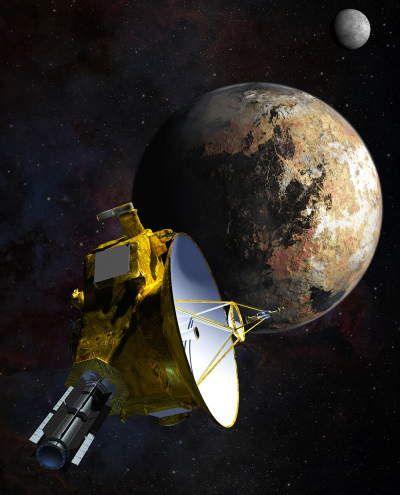NASA Space News 2015: Spacecraft To Start Pluto Mission After 9-Year Voyage

A National Aeronautics and Space Administration spacecraft is set to start its long-awaited mission of taking photographs of Pluto after nine years of traveling into space.
"NASA's first mission to distant Pluto will also be humankind's first close-up view of this cold, unexplored world in our solar system," said Jim Green, director of NASA's Planetary Science Division at the agency's headquarters in Washington. "The New Horizons team worked very hard to prepare for this first phase, and they did it flawlessly."
The piano-sized probe named New Horizons started taking long-range photos on Sunday so scientists can observe the dynamics of Pluto's moons during its close encounter with the mysterious dwarf planet.
Images from the spacecraft will also help scientists map Pluto and its moons more accurately than previous planetary reconnaissance missions.
Considered the world's fastest spacecraft when it was launched in January 2006, New Horizons awoke from its hibernation last month after a more than three-billion-mile voyage. It will soon pass close to Pluto, inside the orbits of its five known moons.
"We've completed the longest journey any spacecraft has flown from Earth to reach its primary target, and we are ready to begin exploring," said Alan Stern, New Horizons principal investigator from Southwest Research Institute in Boulder, Colorado.
In another development, NASA technologies originally for space exploration are now being used to make life better here on Earth.
Such technologies now have broader applications, including shock-absorbers used during space shuttle launches now being utilized to support buildings during earthquakes.
"The game-changing technologies NASA develops to push the envelope of space exploration also improve our everyday lives," said NASA Chief Technologist David Miller in a press release.
A coliform bacteria simplified by NASA is also now being used to test water quality in rural areas around the world.
Cabin pressure monitors that caution pilots when oxygen level is dropping dangerously in their aircraft also have their origin from NASA.
These technologies, among others, are featured in the 2015 edition of NASA's "Spinoff," published yearly since 1976.
 Christians don't have to affirm transgenderism, but they can’t express that view at work: tribunal
Christians don't have to affirm transgenderism, but they can’t express that view at work: tribunal Archaeology discovery: Medieval Christian prayer beads found on Holy Island
Archaeology discovery: Medieval Christian prayer beads found on Holy Island Presbyterian Church in America votes to leave National Association of Evangelicals
Presbyterian Church in America votes to leave National Association of Evangelicals Over 50 killed in 'vile and satanic' attack at Nigerian church on Pentecost Sunday
Over 50 killed in 'vile and satanic' attack at Nigerian church on Pentecost Sunday Ukrainian Orthodox Church severs ties with Moscow over Patriarch Kirill's support for Putin's war
Ukrainian Orthodox Church severs ties with Moscow over Patriarch Kirill's support for Putin's war Islamic State kills 20 Nigerian Christians as revenge for US airstrike
Islamic State kills 20 Nigerian Christians as revenge for US airstrike Man who served 33 years in prison for murder leads inmates to Christ
Man who served 33 years in prison for murder leads inmates to Christ


 Nigerian student beaten to death, body burned over ‘blasphemous’ WhatsApp message
Nigerian student beaten to death, body burned over ‘blasphemous’ WhatsApp message 'A new low': World reacts after Hong Kong arrests 90-year-old Cardinal Joseph Zen
'A new low': World reacts after Hong Kong arrests 90-year-old Cardinal Joseph Zen Iran sentences Christian man to 10 years in prison for hosting house church worship gathering
Iran sentences Christian man to 10 years in prison for hosting house church worship gathering French Guyana: Pastor shot dead, church set on fire after meeting delegation of Evangelicals
French Guyana: Pastor shot dead, church set on fire after meeting delegation of Evangelicals ‘Talking Jesus’ report finds only 6% of UK adults identify as practicing Christians
‘Talking Jesus’ report finds only 6% of UK adults identify as practicing Christians Mission Eurasia ministry center blown up in Ukraine, hundreds of Bibles destroyed: 'God will provide'
Mission Eurasia ministry center blown up in Ukraine, hundreds of Bibles destroyed: 'God will provide' Church holds service for first time after ISIS desecrated it 8 years ago
Church holds service for first time after ISIS desecrated it 8 years ago Burger King apologizes for 'offensive campaign' using Jesus' words at the Last Supper
Burger King apologizes for 'offensive campaign' using Jesus' words at the Last Supper Uganda: Muslims abduct teacher, burn him inside mosque for praying in Christ’s name
Uganda: Muslims abduct teacher, burn him inside mosque for praying in Christ’s name